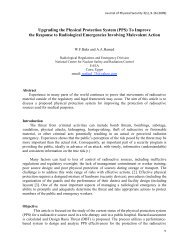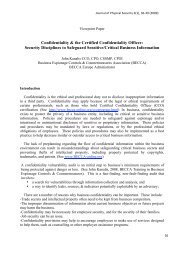PDF - The Journal of Physical Security - Argonne National Laboratory
PDF - The Journal of Physical Security - Argonne National Laboratory
PDF - The Journal of Physical Security - Argonne National Laboratory
You also want an ePaper? Increase the reach of your titles
YUMPU automatically turns print PDFs into web optimized ePapers that Google loves.
<strong>Journal</strong> <strong>of</strong> <strong>Physical</strong> <strong>Security</strong> 4(2), 10-29 (2010)m o = 32,000 lbs TNTm min = 12,000 lbs TNTm max = 64,000 lbs TNTδm = 20,000 lbs TNT [2]<strong>The</strong> mean value, 32,000 lbs, corresponds to 40,000 lb <strong>of</strong> ANFO with a TNT equivalency factor <strong>of</strong> 0.8,whereas the minimum and maximum values, 12,000 and 64,000 lbs, correspond to 40,000 lb <strong>of</strong> ANFOwith TNT equivalency factors <strong>of</strong> 0.3 and 1.6, respectively. <strong>The</strong> dispersion δm = 20,000 lbs has been setequal to m o – m min to describe a likely spread in values comparable to the difference between the nominal0.8 equivalency factor and the minimum equivalency factor <strong>of</strong> 0.3. This spread has been chosen ratherthan a spread equal to the difference between the maximum equivalency factor <strong>of</strong> 1.6 and the nominalfactor <strong>of</strong> 0.8, to weight more heavily the multitude <strong>of</strong> factors that can decrease the TNT equivalency.<strong>The</strong> truncated normal probability distribution F m (m) is displayed in Figure 1 for the numerical parameters<strong>of</strong> eq. [2].F m (m)TNT equivalent mass (lbs)Figure 1. Probability function F m (m) for TNT equivalent mass m for the representative parameters <strong>of</strong> eq. [2].2b. Uncertainty in Stand<strong>of</strong>f DistanceVehicle-borne explosive attacks represent a significant security concern and collateral damageexperienced as a result <strong>of</strong> attacks against nearby facilities is a concern as well. This adds to theuncertainty associated with urban terrorist threats and thereby affects mitigation strategies underconsideration. Strategically placed bollards will prevent a vehicle from ramming a facility as well as set aminimum vehicle access distance. We assume the closest distance <strong>of</strong> approach to a facility and still bewithin the iconic “orbit” <strong>of</strong> its intended target is 275 feet. <strong>The</strong>refore, the stand<strong>of</strong>f distance for a vehicleborneexplosive source should equal or exceed a 275 foot minimum.However, a number <strong>of</strong> vehicle positions that border a target facility are equally likely from a terrorist’sperspective since any point along this border would inflict approximately the same damage to the targetfacility. However, differences in this distance could have a pr<strong>of</strong>ound effect on collateral damage toneighboring facilities. <strong>The</strong> range <strong>of</strong> likely detonation positions relative to potential explosive damage to a13





